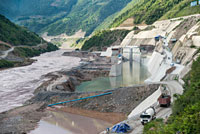
The Mekong
The Mekong starts out as a trickle in snowbound country around 5,200 metres in Tibet. The river gathers momentum, becoming a roaring torrent as it swirls through deep gorges, dropping an astonishing 4,500 metres in elevation through Tibet and China, over a distance of 1,800 kilometres—before turning tamer in Laos. The entire length of the river is estimated at 4,900 kilometres.
The river is known under many names as it courses through different nations: Dza Chu (Tibet), Lancang Jiang (China), Mekaung Myit (Burma), Menam Khong (Thailand), Tonle Thom (Cambodia), and Song Me Kong (Vietnam). There are more name variations for upper, middle or lower reaches within China. In Vietnam, at the tail-end of the river, the sprawling Mekong Delta is called Song Cuu Long (Nine Dragons River).
Large Dams
Huaneng Corporation has constructed most dams on the Mekong, including Xiaowan and Nuozhadu. There are currently 12 huge dams in operation in Yunnan, SW China: Nuozhadu, wall height 261m; Xiaowan, wall height 292m; Manwan, wall height 132m; Dachaoshan, wall height 111m; Jinghong, wall height 110m; Gongguoqiao, wall height 105m; Miaowei, wall height 140m; and Dahuaqiao, wall height 106m. For another 4 dams completed in Yunnan, see the map data. Lidi Dam is a SinoHydro project. Huangdeng Dam is the only one of the Mekong cascade that has paid attention to fish lifts. There are more large dams under way in Laos and projected for Cambodia, with Chinese backing. Two dams are operational on the Mekong mainstream in Laos—at Xayabouri and Don Sahong (SinoHydro). The largest dam currently operational in Cambodia is Lower Sesan 2, built by Huaneng Corporation, and located on a Mekong tributary in the NE of the country in the Stung Treng region. All bad news for fish, and very bad news for fisheries.
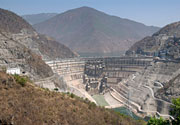
Xiaowan Dam, Mekong, Yunnan
wall height 292m
© mqrphoto
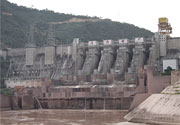
Manwan Dam, Mekong, Yunnan
wall height 132m
© mqrphoto
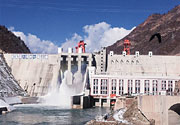
Guoduo Dam, 165 MW capacity, started in 2014. Sited on a Mekong tributary north of Chamdo, this dam was built to power Yulong Copper Mine, the largest in Asia
The first big dam on the Mekong, the Manwan Dam, opened in 1994. Up until then, the Mekong River was barely touched. The colonial French tried a few things—mostly blasting rocks to improve navigation by boat. Since the start-up of Manwan Dam in Yunnan—and the addition of three more mega-dams—there has been lots of trouble. As of 2010, the Mekong region is suffering its worst drought in five decades, with parched landscapes in Yunnan, Laos and Thailand. Water levels are so low that the turbines in some dams, like Jinghong Dam in Yunnan, cannot operate.
Nuozhadu is a colossal dam, with wall-height of 261 metres, and an expected output of 5850 megawatts, the equivalent of five large nuclear reactors. The dam's reservoir is a whopping 226 km long. Work on this monster dam started in 2006, and was completed in 2014, with its huge reservoir slowly filling up.
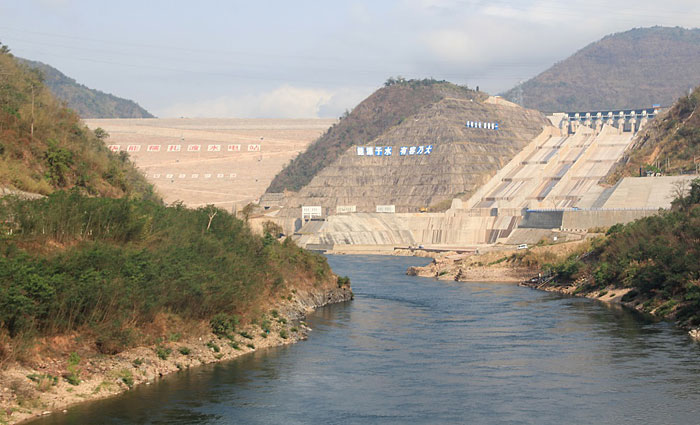
Nuozhadu is the 4th largest dam in China
Murder on the Mekong
No, not a detective mystery—but a stark description summing up how an entire river can be hijacked, strangled, and become lifeless. Megadams are the death knell for the Mekong. The real mystery is how China gets away with this. More than any other transboundary river sourced in Tibet, the Mekong is the most likely to fail. Check off the Fail marks: Fail for fish, Fail for protein supply, Fail for rich silt to fertilise crops. Fail for volume of clean water needed for agriculture in five nations downstream—in Burma, Thailand, Laos, Cambodia and Vietnam.
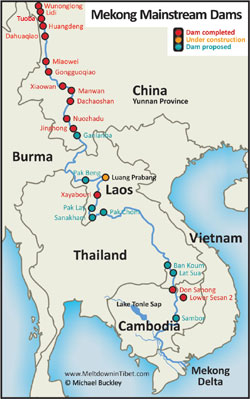
Click to expand
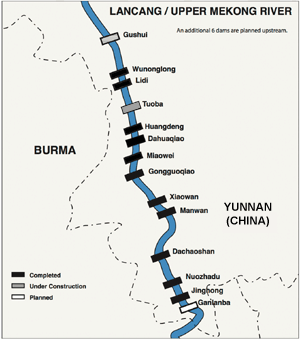
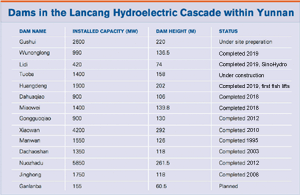
Upper Mekong Dams
source: International Rivers

On the road travelling north from Weixi, in upper Yunnan, a new dam under construction on the Mekong (mid-2014)
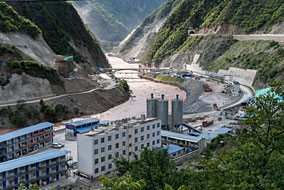
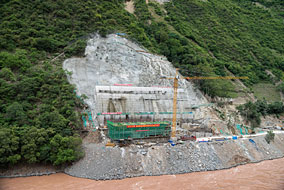
On the road travelling north from Weixi, in upper Yunnan, photos of Wunonglong Dam under construction on the Mekong (mid-2014)
James Clad, a senior research fellow at the Institute for National Strategic Studies at the National Defense University, said China's presence and impact, potential and real, on the Mekong is “so predominant, so overwhelming, that it does affect, literally, the ability of these countries to continue earning a living, irrigating their fields in the way that they've been accustomed to for millennia.” He called the dams' construction “probably the most dramatic use of water resources to reorder a geopolitical area that I've ever seen.”
Australian author, historian and consultant on southeast Asian affairs, Milton Osborne, says the way the Chinese have resorted to misleading statements and information in their attempts to defend themselves against charges that Chinese dams are destroying the ecology of the Mekong. Osborne points to China's regular response that it can't be held responsible for what happens on the lower Mekong, because only about 13 per cent of the water in the river at that point comes from China. This, Osborne says, is nonsense because during the dry season, when the effects on features such as Cambodia's Lake Tonle Sap are most profound, at least 40 per cent of the water in the Mekong comes from China.
Claude Arpi, a Tibetologist living in India, is much blunter (quote from: claudearpi.blogspot.com)—
"Beijing has so far refused to be a member of the Mekong Commission, considering that the mighty river belongs to Middle Kingdom and therefore the Chinese leadership does not need to inform the four downstream nations when megadams are built in Yunnan Province of China.
This is called international collaboration with Chinese characteristics."
CHINESE DAMS ACCUSED OF FLOODING THE REGION
China's Mekong dams release billions of tons of water as a safety measure after Sichuan earthquake
By Lawi Weng
Friday, November 14, 2008
Many of the 300 representatives at a recent forum in Bangkok have blamed Chinese authorities for releasing water from three hydropower dams on the Mekong River in August, which devastated hundreds of communities downstream.
The accusations were aired at a forum titled "Mekong Mainstream Dams: Voices across Borders," which was held at Chulalongkorn University in the Thai capital from November 12-13. Most of the 300 community leaders, environmentalists and activists attending the meeting were from the six nations comprising the Greater Mekong Subregion—China, Burma, Laos, Thailand, Cambodia and Vietnam. The two-day forum focused on the devastation and loss of lives and livelihoods following floods in the subregion in August.
Witoon Permpongsachareon, a coordinator with the Mekong Energy and Ecology Network, told The Irrawaddy on Friday that many representatives at the forum pointed fingers at China's hydropower Mekong River dams—Manwan, Dachaoshan and Jinghong—which released billions of tons of water as a safety measure in May after Sichuan Province in western China was hit by an earthquake. The resulting floods destroyed thousands of homes, farms and livelihoods in Mekong River communities downstream and affected millions of people.
"The representatives are annoyed with the Chinese government and they send strong messages to the government to respect other people's rights," he said. According to a report in Fridays' The Bangkok Post, a former headmaster at Chiang Khong School in Chiang Rai Province, northern Thailand, accused the Chinese of causing the heaviest floods in the area for 40 years.
"At least three districts [in northern Thailand] have yet to recoup the financial loss of 85 million baht (US $2.4 million)" said the headmaster. "Not to mention the heartbreak of being fooled by authorities that dams help prevent flooding, serve agriculture and produce electricity."
However, a chief executive officer from the Mekong River Commission (MRC) claimed that the Chinese dams were not responsible for the regional flooding and blamed the Laotian authorities.
The representatives at the forum also spoke about the impact of dams on the natural ecosystem in the river. Many fish are unable to travel to feed or spawn because the dams block the river. Fish production in the Mekong is decreasing every year and more dams are being built in China, Laos, Thailand and Cambodia, according to the Mekong River Commission Fisheries Program.
According to data from the commission, the Mekong River is the world's largest inland fishery with some 1.5 to 3 million tonnes of fish products per year.
Speaker after speaker at the seminar urged the six countries' governments to reduce their reliance on electrical power.
Over the next few years, Laos is planning to construct at least seven dams, with a total electricity generating capacity of 7,470 megawatts, while another two Thai-Lao projects will produce a total of 3,409 megawatts. Cambodia, too, has released plans for two hydropower dams—at Stung Treng and Sambor.
MEKONG RIVER COMMISSION
All talk, no action?
The Mekong River Commission (MRC) was established in 1995 to tackle trans-boundary river issues on the Mekong—with the express aim of protecting the Mekong from further damage. But since then, dam building continues at a rapid pace—and not just in China. Mekong river dolphins are dying off fast, due to high levels of pollution. And fish catches on the Mekong have dropped considerably since mega-dams started operating in lower Yunnan in China.
The MRC has consumed large quantities of cash from various grants and government bodies, but this has produced little or no action on these matters. On November 12, 2007, a petition was delivered to the CEO of the MRC, Jeremy Bird. With half a dozen major dam projects looming on the horizon in the lower Mekong countries, the petition demanded that the MRC fulfil its mission to protect the river, in light of compelling scientific evidence that warns of the disastrous consequences of damming the lower Mekong. The petition was endorsed by 201 organisations and individuals from 30 countries, with unprecedented support from civil society groups from Mekong countries.
In a meeting held on 11/15/2007 at Siem Reap, a protest letter was addressed to the Mekong River Commission and financial institutions. It observed that the MRC has “remained notably silent”, in the face of these new hydropower projects. The letter added “If the MRC does not act now to uphold the 1995 Agreement and defend the ecological integrity of the Mekong, the institution is a river authority in name only and does not deserve the tens of millions of dollars worth of grant and technical assistance that it receives from international donor agencies.” (12)
One of the MRC's greatest setbacks is that it has failed to coax China and Burma to join the organisation. China and Burma sit on the sidelines as 'dialogue partners' and are thus not bound by any agreements reached. Instead of trying to stop the building of new dams, the MRC seems to pussyfoot around the issues. Chief Executive Officer of the MRC, Jeremy Bird, made this extraordinary statement in comments reported by a Vietnamese journal: 'mitigation efforts for fisheries were being explored. Fish ways, if properly constructed, could allow migratory species to pass through a mainstream hydroelectric dam.'
With this statement, Jeremy Bird is contradicting the conclusions of his own organisation. When a panel of 17 experts was convened 2008 by the MRC to study the possibility of mitigating the effects of dams built on the mainstream of the river, they reached the unanimous conclusion that all three suggested ways of achieving mitigation would fail—including the construction of fish ways, or bypasses, that would allow fish to swim around dams.
Ever seen a fish attempt to get around a dam that is 300 metres in wall height? Perhaps this calls for breeding of a new species of super-fish with suckers that can tackle steep walls? Or perhaps the fish need to evolve with the dams and develop wings?
>>Next: The Yangtse
Return to River by River main page










